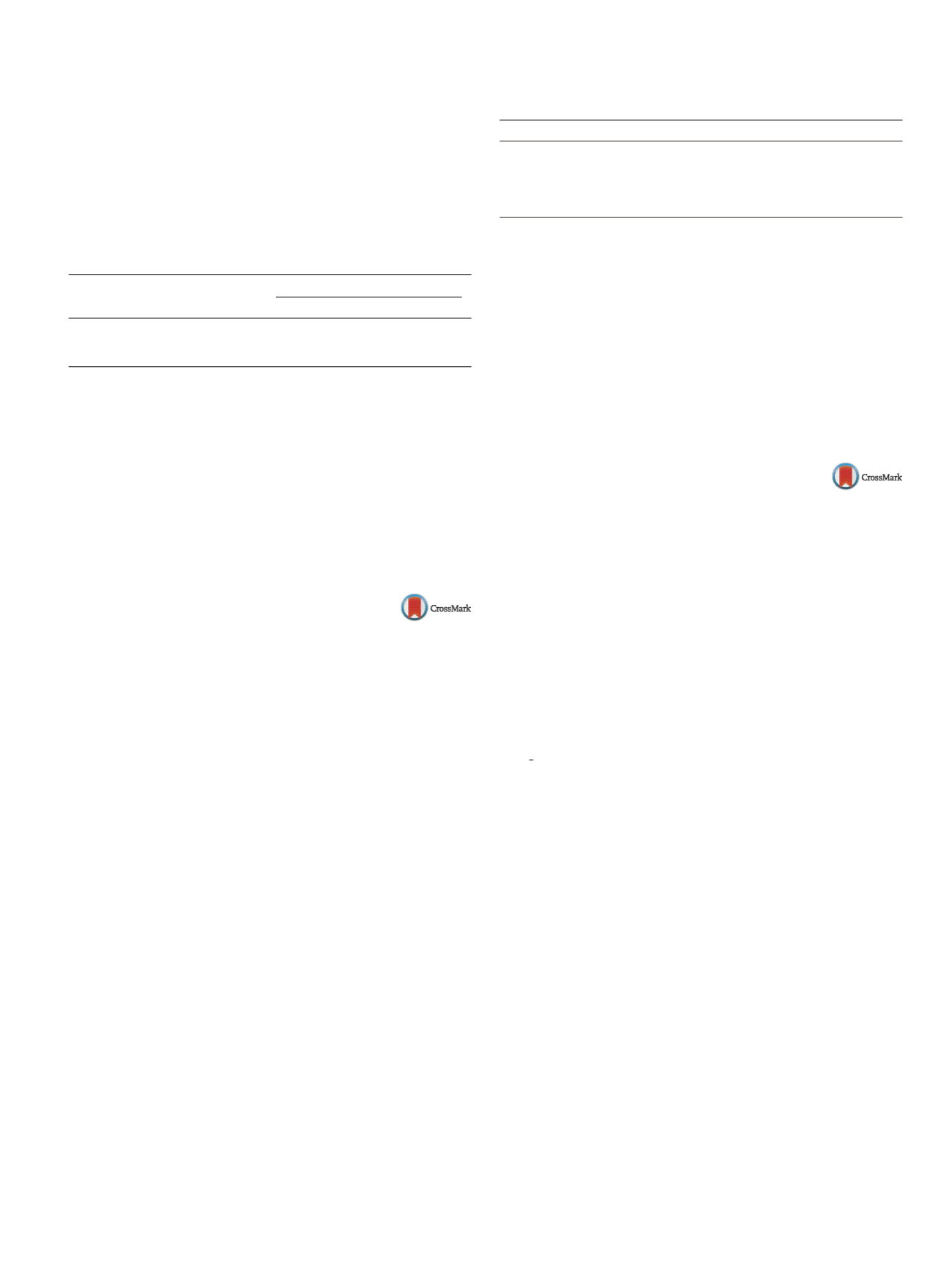

Abstracts / Journal of Clinical Virology 82S (2016) S1–S142
S89
Europe N.V, Gent, Belgium) for confirmation. Sensitivity was evalu-
ated using 49 frozen HTLV-I positive serum specimens (confirmed
by Immunoblot INNO-LIA HTLV I/II Score).
Results:
Among 663 routine samples, 658 samples were nega-
tive with ARCHITECT and LIAISON
®
. 5 and 3 samples were reactive
with ARCHITECT and LIAISON
®
respectively. The 2 discrepancies
samples (weakly reactive with ARCHITECT) were not confirmed by
immunoblot. LIAISON
®
XL and ARCHITECT rHTLV had an overall
agreement of 99.7% with 100% negative agreement.
The results are summarized in the following table.
LIAISON
®
XL murex recHTLV-I/II
ARCHITECT rHTLV-I/II
Positive
Negative
Total
Positive
3
0
3
Negative
2
658
660
Total
5
658
663
In addition, all 49 positive HTLV-I samples were detected by
these 2 assays.
Conclusion:
The HTLV assay performance of LIAISON
®
and
ARCHITECTwere equivalent. LIAISON
®
XLmurex recHTLV-I/II assay
demonstrated very good specificity and sensitivity. It was appropri-
ate for the large-scale screening of samples forHTLV-1/2 antibodies.
http://dx.doi.org/10.1016/j.jcv.2016.08.176Abstract no: 210
Presentation at ESCV 2016: Poster 137
The seroprevalence of HBV, HCV and HIV in
blood donors
U˘gur Tüzüner
1 ,∗
, Mehmet Özdemir
1,
Bahadır Feyzio˘glu
1 , Mahmut Baykan
21
Necmettin Erbakan University, Meram Medical
Faculty, Medical Microbiology Department, Medical
Virology Division, Turkey
2
Necmettin Erbakan University, Meram Medical
Faculty, Medical Microbiology Department, Turkey
Objective:
Transfusion-transmitted infections, are the most
important complications in blood banking. Blood centers in Turkey
applymandatory screening tests for HBsAg, anti-HCV, anti-HIV-1/2
and VDRL/RPR to blood donors. We aimed to evaluate the sero-
prevalence of HBV, HCV and HIV at healthy volunteer blood donor
who applied blood centre of Meram Medical Faculty of Necmettin
Erbakan University.
Material andmethods:
In this study, blood donor screening test
results between January 2013–April 2016 in Necmettin Erbakan
University Meram Medical Faculty Blood Center have been inves-
tigated retrospectively. Of all applicants evaluated in terms of
donor suitability and 79.099 healthy donors were screened. Sera
of blood donors were analyzed for HBsAg, anti-HCV and anti-HIV-
1/2 in the automated device by chemiluminescence microparticle
immunoassay principle. Autologous and repeated donations were
not included in the study. Results of donors were analyzed and
seropositivity rates were determined according to years.
Results:
According to the screening test results, the rates of
seropositivity for HBsAg, anti-HCV, and, anti-HIV-1/2 were found
to be 2.81%, 0.82%, and 0.06% respectively
( Table 1 ).Conclusion:
Transmission of various infectious agents often
including viruses to the recipients, is the most common complica-
tion of blood transfusion. These agents can cause asymptomatic,
acute, chronic and latent infections. Preparation of safe blood
for transfusion is done through detailed questioning of donors
Table 1
HBsAg, anti-HCV, and anti-HIV-1/2 seropositivity rates.
Years
Positive HBsAg
Positive anti-HCV Reactive anti-HIV-1/2
2013
2.3%
0.95%
0.02%
2014
2.9%
0.8%
0.11%
2015
3.05%
0.73%
0.06%
2016
3.2%
0.81%
0.01%
Total
2.81%
0.82%
0.06%
and screening tests. World Health Organization recommends that
screening all donated blood for transfusion-transmitted infections
like HBV, HCV, HIV and syphilis should be mandatory. In our study,
we determined the prevalence of HBV, HCV andHIV inKonya region
with these parameters. The ratios obtained in blood center are con-
sistent with similar studies conducted in Turkey.
Keywords:
Blood donor; HCV; HIV; HBV; Seroprevalence
http://dx.doi.org/10.1016/j.jcv.2016.08.177Abstract no: 227
Presentation at ESCV 2016: Poster 138
Characterization of Epstein–Barr Virus LMP1
deletion variants by Next-Generation
Sequencing in HIV-associated Hodgkin
Lymphoma (French ANRS CO16 LYMPHOVIR
cohort)
C. Sueur
1 ,∗
, J.Lupo
1 , R. Germi
1 , N.Magnat
1 ,S. Prevost
2, V. Boyer
1, D. Costagliola
3,
C. Besson
4, P. Morand
11
Institut de Biologie Structurale Grenoble,
Laboratoire de Virologie, CHU de Grenoble,
Université Grenoble Alpes, France
2
Université Paris Sud, Faculté de médecine Paris Sud,
Le Kremlin-Bicêtre AP-HP, Hôpitaux Paris Sud Site
Béclère, Service d´anatomo-pathologie, Clamart,
France
3
Sorbonne Universités, UPMC Univ Paris 06 INSERM,
UMR S 1136, Institut Pierre Louis d ´épidémiologie et
de Santé Publique, Paris, France
4
Université Paris Sud, Faculté de médecine Paris Sud,
Le Kremlin-Bicêtre AP-HP, Hôpitaux Paris Sud,
Service d ´hématologie, Le Kremlin-Bicêtre, France
Background:
Among HIV+ patients, Epstein–Barr virus (EBV)
is associated with 80–100% of Hodgkin’s Lymphoma (HL) cases
and the viral oncogenic protein LMP1 (latent membrane protein
1) is regularly expressed in the tumoral Reed-Sternberg cells. Two
C-terminal deletion LMP1 variants (del30-LMP1 and del69-LMP1)
have been described in animal models to be more tumorigenic
than Wild-Type-LMP1 (WT-LMP1). This work aimed to character-
ize the LMP1 variant frequency with a next generation strategy
in HIV+/HL+ patients of the French prospective ANRS CO16 LYM-
PHOVIR cohort.
Methods:
The cohort recruited 82 HIV+ patients with Hodgkin
Lymphoma (HIV+/HL+) between 2008 and 2015. Fifty-five whole
blood samples (WB), 45 oropharyngeal cells pellets (OC) and 19
tumor biopsies (paraffin-embedded) from these HIV+/HL+ patients
were available for analysis. Forty-sevenHIV-positive patients with-
out lymphoma (HIV+/HL
−
) and 14 HIV-negative patients with HL
(HIV
−
/HL+) were recruited as control populations at the Grenoble
University Hospital and provided WB and OC samples. After total
DNA extraction, the C-terminal region of
LMP1
(344 bp) surround-
ing the 30 bp and 69 bp deletions was amplified by nested-PCR and
sequenced by next-generation sequencing (GS Junior – Roche 454).


















